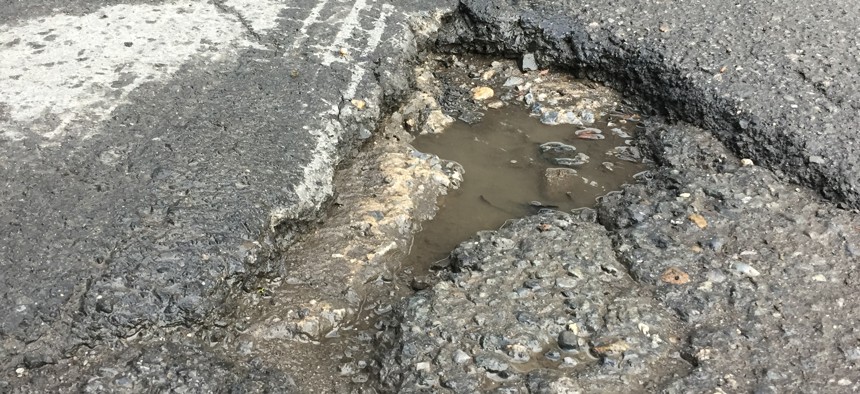Opinion
The equitable dilemma of NYC’s potholes
How are potholes linked to equity? New York City is a prime example of how they are.

Photography by Keith Getter
We often think of potholes as a frustrating – but straightforward – part of life. They’re just holes in the roadways, right?
In truth, potholes can be quite complicated, stemming from a legacy of inequitable infrastructure decisions that have plagued communities for generations. For this reason, it’s important that cities – including New York City – not overlook these seemingly simple frustrations, and instead proactively address them.
How are potholes linked to equity? New York City is a prime example. Analysis has found that street quality in the Big Apple often has a direct correlation with a neighborhood’s median income. In other words, disadvantaged neighborhoods and low-income residents face worse street conditions than higher income neighborhoods. Poor street conditions are in turn connected to traffic accidents and vehicle damage. (Indeed, in Montreal, car accidents and injuries are up to six times more common in low-income communities.) The result? The city’s most vulnerable communities are impacted the most by potholes.
The causes of potholes should also be noted. While weather conditions play a large role in the formation of potholes, traffic patterns are also a major factor. Heavier vehicles, such as multi-axel trucks, can cause potholes, especially on roads that were not designed to support such heavy loads. This means that potholes are more commonplace for communities living and working near industrial centers and transit arteries, communities that are typically lower income and that already bear the brunt of air pollution caused by transportation.
For these reasons, filling in potholes shouldn’t be at the bottom of city leaders’ to-do lists. Nor should the solution be as simple as pouring asphalt and moving on. If equity is to be prioritized, a clear strategy is needed.
Build equitable infrastructure. The first part of the solution entails a major rethinking of how New York and similar cities have traditionally been built and maintained. Historically, infrastructure investment in communities has been unequal: policies like redlining, established in the 1950s, continue to persist today. Communities of color did – and still do – have lesser infrastructure. Worse, the creation of the Interstate Highway System often disconnected or even outright razed communities, many of which were immigrant communities and/or communities of color. This occurred across the country, from Memphis to Minneapolis – including New York City.
It’s critical for city leaders to acknowledge this inequity – and then address it head on. Leaders should seek out communities that have been negatively impacted by transportation and infrastructure decisions, and then make investments in new roadways and repairs of existing ones. Some cities are already doing exactly this. In Oakland, for example, the city has promised $100 million for repairing potholes and roads in the region’s poorest communities. The federal government also recently launched a pilot initiative to reconnect neighborhoods impacted by redlining.
There is also rethinking traffic volume distribution. The second part of the solution is all about traffic. Routing vehicles through low-income neighborhoods at a disproportionate rate means much more traffic on those roads – and thus more wear-and-tear, more potholes, and more accidents. Further, pedestrians and other non-motorists in these neighborhoods – like bicyclists – are more likely to be involved in an accident. It’s vital that city leaders address this and rethink traffic volume. As new roads and routes are built, they shouldn’t impose on the most vulnerable communities. And in the meantime, action can be taken to address the issues that accompany high-traffic volume – more safety measures (lights, crosswalks) for busy areas; efforts to reduce air pollution; and initiatives to build green spaces back into communities that lost it to asphalt.
The New York City Department of Transportation recently released the first NYC Streets Plan, a five-year transportation plan developed to guide improvements to the city’s streets. The plan, which involved an in-depth analysis of the current state of New York City’s streets and extensive community outreach led by Public Works Partners, provides a framework for improving the safety and quality of streets across the City.
Potholes may seem like a minor thing, but in many ways they exemplify the importance of equitable infrastructure. If city leaders, in New York and beyond, want to build truly equitable communities, they need to think of every detail – including that hole in the street just down the block.
Celeste Frye is co-founder and CEO of Public Works Partners.
Editor's Note: The data cited in this opinion piece was based on a self-published blog post where the author explains that the correlation found was only "in some areas" and not everywhere in New York City, therefore "correlation does not imply causation." The New York City Department of Transportation reached out to NYN Media to note that, "Comparing resurfacing miles, average income, and average non-white percentage for each of NYC’s 190 neighborhoods, our own analysis shows no correlation whatsoever between resurfacing lane miles allocated to a neighborhood and its income or average minority.
NEXT STORY: Foster kids need more educational help now
